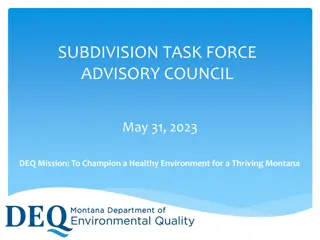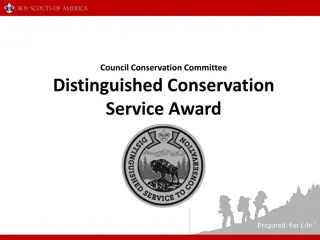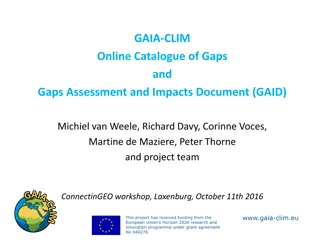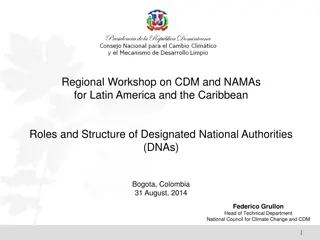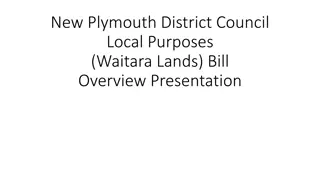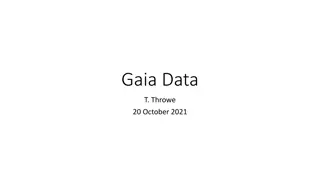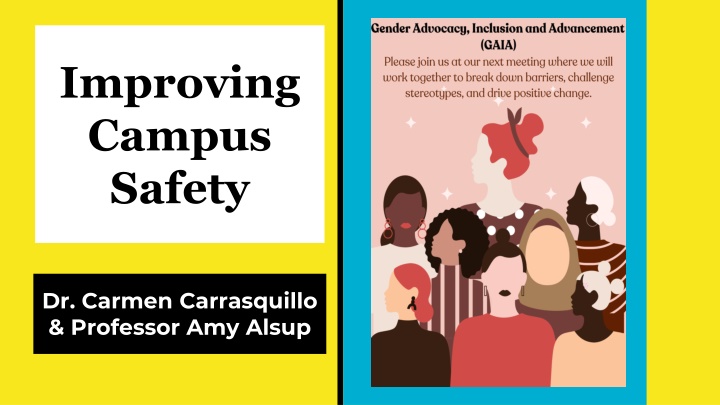
Enhancing Campus Safety Through Legislative Measures and Institutional Collaboration
Discover the evolution of campus safety initiatives, from the implementation of the Higher Education Act of 1965 to the current challenges faced by educational institutions in handling cases of discrimination and harassment. Learn about key legislative acts, such as VAWA and the Clery Act, that aim to address campus safety concerns. Explore the importance of transparency, collaboration, and education in promoting student well-being on campuses.
Download Presentation

Please find below an Image/Link to download the presentation.
The content on the website is provided AS IS for your information and personal use only. It may not be sold, licensed, or shared on other websites without obtaining consent from the author. If you encounter any issues during the download, it is possible that the publisher has removed the file from their server.
You are allowed to download the files provided on this website for personal or commercial use, subject to the condition that they are used lawfully. All files are the property of their respective owners.
The content on the website is provided AS IS for your information and personal use only. It may not be sold, licensed, or shared on other websites without obtaining consent from the author.
E N D
Presentation Transcript
Improving Campus Safety Dr. Carmen Carrasquillo & Professor Amy Alsup
Campus Safety The Higher Education Act of 1965 (HEA) was implemented to provide various resources and financial assistance for students in higher education institutions (The American Association of Collegiate Registrars and Admissions Officers (AACRAO, n.d.). In 1990, the Act was amended with Title II: the Crime Awareness and Campus Security Act (CACSA), which requires higher education institutions to disclose crime statistics from the last three years and current institutional security policies (United States Department of Education, 2016).
Campus Safety In 1994, the Violence Against Women Reauthorization Act (VAWA) was first enacted, which renews every five years (The National Network to End Domestic Violence, 2024). In 1998, the Crime Awareness and Campus Security Act (CACSA) was renamed the Jeanne Clery Disclosure of Campus Security Policy and Campus Crime Statistics Act (the Clery Act) to memorialize a student who was tragically murdered while in her dorm room (United States Department of Education, 2020).
Campus Safety Under VAWA, colleges and universities are required to: Report domestic violence, dating violence, and stalking, beyond crime categories the Clery Act already mandates Adopt certain student discipline procedures, such as for notifying purported victims of their rights Adopt certain institutional policies to address and prevent campus sexual violence, such as to train in particular respects pertinent institutional personnel (American Council on Education, 2014).
Campus Safety Despite all these federal efforts, and other important state-wide legislative moves, a 2024 California Assembly Higher Education Committee report detailed widescale distrust and resentment of the way their institutions handle Title IX cases (Smith, 2024). The prevailing message from students, staff and faculty is that current policies of the CCC, CSU, and UC do not protect survivors" of discrimination and sexual harassment appropriately (Smith, 2024, para. 4).
Campus Safety The organization Student Affairs Administrators in Higher Education (NASPA) released a 2024 report after asking senior leaders in student affairs to indicate what they view as most important to their institutions. The top ten concerns revolved around preserving student well-being on campus. 83% identified the need for health, safety, and well-being education, and 80% emphasized increased campus-wide collaboration in these areas (Student Affairs Administrators in Higher Education, 2024, para. 1). Experts in the field agree that improving campus safety requires transparency and collaboration among different sectors of a campuses and districtwide efforts.
Improving Campus Safety: A Shared Responsibility Recommended Actions from GAIA Gender Advocacy, Inclusion and Advancement 1. Educate 2. Protect 3. Improve
Improving Campus Safety: A Shared Responsibility Recommended Action #1: EDUCATE Bystander intervention training for all Campus-wide Safety Fair to teach about policies, processes, resources Campus Safety Forum (guests SDCCD Campus Police; Title IX Coordinator; VC People, Culture & Technology) Syllabus statements Safety presentations to classes, departments, clubs and programs Elevated communication: Agendize campus safety at ASG, Senates, College Council to increase awareness and collaborate on actionable strategies. Outreach: Post flyers that include emergency phone numbers and a QR code to a reporting form. Embedded Anti-stalking Awareness Campaign
Improving Campus Safety: A Shared Responsibility Recommended Action #1: EDUCATE Review broadly the SDCCD Annual Security Report (Safe and Sound), 2021- 2023 24-hour College Police Communications Center at 619-388-6405. From campus building phones, press the college police button for immediate assistance. Criminal action and any other incidents may also be reported via email to the SDCCD Police Department at police@sdccd.edu. When a sexual assault, dating violence, domestic violence or stalking incident is reported to College Police, staff on the scene, including College Police, will offer the victim a variety of District and other local resources.
Improving Campus Safety: A Shared Responsibility Recommended Action #1: EDUCATE SDCCD Annual Security Report, Campus Security Authority (CSA) Faculty members who do not have responsibility for student and campus life beyond the classroom, clerical staff, cafeteria staff, facilities staff, and maintenance staff are not considered CSA s; however, they are not prohibited from reporting crimes and are encouraged to do so for accurate record keeping by the District. The District will issue Timely Warning Notices whenever a Clery Crime is committed on District property or on adjoining public property and the District believes that there may be a serious or continuing threat to students and employees. District employees and students are automatically registered on the RAVE Alert platform.
Improving Campus Safety: A Shared Responsibility Recommended Action #2: PROTECT Safe Walk Service Community Safety Patrols Designated Safety Ambassador for each School/Area More support for womxn's organizations and clubs: leadership conferences and retreats to collaborate on solving issues affecting womxn on campus Designated Womxn's Resource Center Womxn's Empowerment Week Resource fair, films, art, guest speakers If students feel unsafe walking alone, they can call our communication center, and we will send an officer to escort them. o Lt. Nelson, SDCCD Police Department
Improving Campus Safety: A Shared Responsibility Recommended Action #2: PROTECT Post-election Considerations: The Influence of Political Actors .....a blistering series of attacks on refugees, immigrants, the environment, public health, women, workers, people of color, LGBTQIA+ people, and the middle-class" (Oxfam). How can we proactively protect our most vulnerable communities going forward?
Improving Campus Safety: A Shared Responsibility Recommended Action #2: PROTECT Cheryl Barnard, Ph.D. 619-388- 7485 cbarnard @sdccd. UndocuLiaisons are located on California community college campuses to provide answers and support for undocumented students of all nationalities and backgrounds. These resources provide a safe community for UndocuScholars and a judgement free place that makes it easier for students to focus on school and know they have support. Find your nearest UndocuLiaison San Diego Miramar College 619.388.7800 10440 Black Mountain Road, San Diego, 92126 www.sdmiramar.ed 0.9 edu Undocum ented student resources & support services u
Improving Campus Safety: A Shared Responsibility Recommendation #2: PROTECT Post election considerations Offer a more visible protection campaign through cross-group dialogue and unity events. Collect, disaggregate and analyze new data on campus safety perceptions through multiple measures to implement intervention strategies. Re-visit the Reimagining Campus Policing Recommendations Students should be seen as equal partners in ensuring campus safety and leading campus change. This means acknowledging the power dynamics that may prevent students from fully participating.
Improving Campus Safety: A Shared Responsibility Recommended Action #3: IMPROVE Audit our campus justice process. Put a reporting form on the website and share widely.
Improving Campus Safety: A Shared Responsibility Recommendation #3: IMPROVE Anti-violence and anti-harassment policies, incident reporting, investigation protocols, and potential actions need to be clearer and more transparent. Shorten the time frame for implementing identified interventions. Encourage open communication and thoughtful responses for the common good.
References American Council on Education. (2014). New Requirements Imposed by the Violence Against Women Reauthorization Act. https://www.acenet.edu/Documents/VAWA-Summary.pdf National Network to End Domestic Violence (NNEDV). (2024). Violence Against Women Act. (https://nnedv.org/content/violence-against-women-act/ Smith, A.A. (2024, February 6). Students, faculty, staff distrust state college systems handling of Title IX cases. EdSource. https://edsource.org/2024/students-and-faculty-distrust-state-college-systems-handling- of-title-ix-cases/705360 Student Affairs Administrators in Higher Education (NASPA). Addressing Critical Campus Issues in 2024: How NASPA s Culture of Respect Collective is Leading the Charge on Sexual Violence Prevention and Student Well-being. https://www.naspa.org/blog/addressing-critical-campus-issues-in-2024-how-naspa-s- culture-of-respect-collective-is-leading-the-charge-on-sexual-violence-prevention-and-student-well-being The American Association of Collegiate Registrars and Admissions Officers (AACRAO) (n.d.) Higher Education Act. https://www.aacrao.org/advocacy/issues/higher-education-act United States Department of Education (2016). The Handbook for Campus Safety and Security Reporting 2016 Edition. https://www.ed.gov/sites/ed/files/admins/lead/safety/handbookfsa.pdf






